Indirect Tax
VerifiedAdded on 2020/12/24
|14
|4255
|291
Homework Assignment
AI Summary
This assignment provides a detailed analysis of indirect tax, particularly focusing on Value Added Tax (VAT) in the UK. It covers various aspects of VAT, including registration requirements, reporting procedures, penalties for non-compliance, and the impact of VAT on an organization's cash flow and financial forecasts. The assignment also includes practical examples and insights into navigating VAT regulations effectively.
Contribute Materials
Your contribution can guide someone’s learning journey. Share your
documents today.

Indirect tax
Secure Best Marks with AI Grader
Need help grading? Try our AI Grader for instant feedback on your assignments.
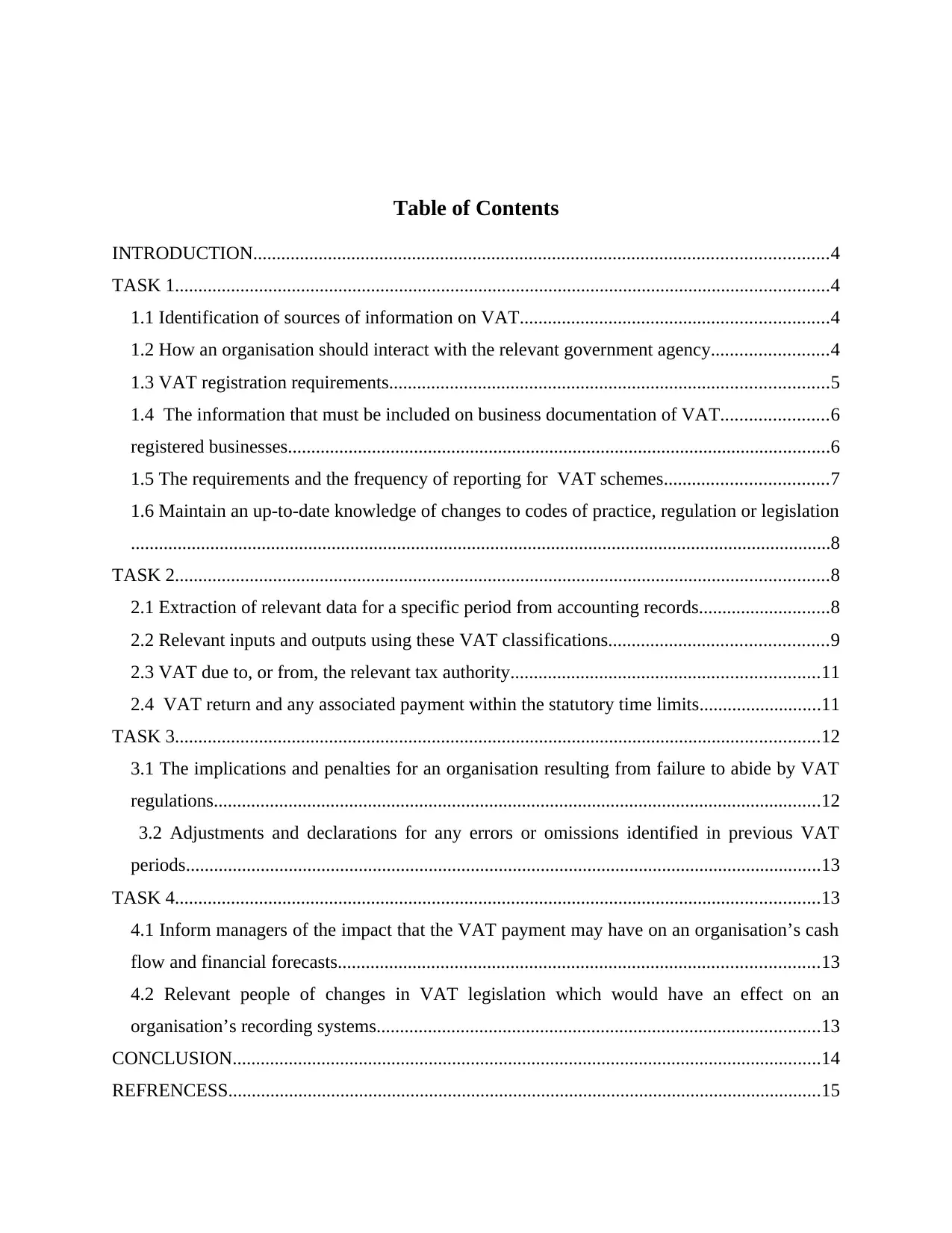
Table of Contents
INTRODUCTION...........................................................................................................................4
TASK 1............................................................................................................................................4
1.1 Identification of sources of information on VAT..................................................................4
1.2 How an organisation should interact with the relevant government agency.........................4
1.3 VAT registration requirements..............................................................................................5
1.4 The information that must be included on business documentation of VAT.......................6
registered businesses....................................................................................................................6
1.5 The requirements and the frequency of reporting for VAT schemes...................................7
1.6 Maintain an up-to-date knowledge of changes to codes of practice, regulation or legislation
......................................................................................................................................................8
TASK 2............................................................................................................................................8
2.1 Extraction of relevant data for a specific period from accounting records............................8
2.2 Relevant inputs and outputs using these VAT classifications...............................................9
2.3 VAT due to, or from, the relevant tax authority..................................................................11
2.4 VAT return and any associated payment within the statutory time limits..........................11
TASK 3..........................................................................................................................................12
3.1 The implications and penalties for an organisation resulting from failure to abide by VAT
regulations..................................................................................................................................12
3.2 Adjustments and declarations for any errors or omissions identified in previous VAT
periods........................................................................................................................................13
TASK 4..........................................................................................................................................13
4.1 Inform managers of the impact that the VAT payment may have on an organisation’s cash
flow and financial forecasts.......................................................................................................13
4.2 Relevant people of changes in VAT legislation which would have an effect on an
organisation’s recording systems...............................................................................................13
CONCLUSION..............................................................................................................................14
REFRENCESS...............................................................................................................................15
INTRODUCTION...........................................................................................................................4
TASK 1............................................................................................................................................4
1.1 Identification of sources of information on VAT..................................................................4
1.2 How an organisation should interact with the relevant government agency.........................4
1.3 VAT registration requirements..............................................................................................5
1.4 The information that must be included on business documentation of VAT.......................6
registered businesses....................................................................................................................6
1.5 The requirements and the frequency of reporting for VAT schemes...................................7
1.6 Maintain an up-to-date knowledge of changes to codes of practice, regulation or legislation
......................................................................................................................................................8
TASK 2............................................................................................................................................8
2.1 Extraction of relevant data for a specific period from accounting records............................8
2.2 Relevant inputs and outputs using these VAT classifications...............................................9
2.3 VAT due to, or from, the relevant tax authority..................................................................11
2.4 VAT return and any associated payment within the statutory time limits..........................11
TASK 3..........................................................................................................................................12
3.1 The implications and penalties for an organisation resulting from failure to abide by VAT
regulations..................................................................................................................................12
3.2 Adjustments and declarations for any errors or omissions identified in previous VAT
periods........................................................................................................................................13
TASK 4..........................................................................................................................................13
4.1 Inform managers of the impact that the VAT payment may have on an organisation’s cash
flow and financial forecasts.......................................................................................................13
4.2 Relevant people of changes in VAT legislation which would have an effect on an
organisation’s recording systems...............................................................................................13
CONCLUSION..............................................................................................................................14
REFRENCESS...............................................................................................................................15
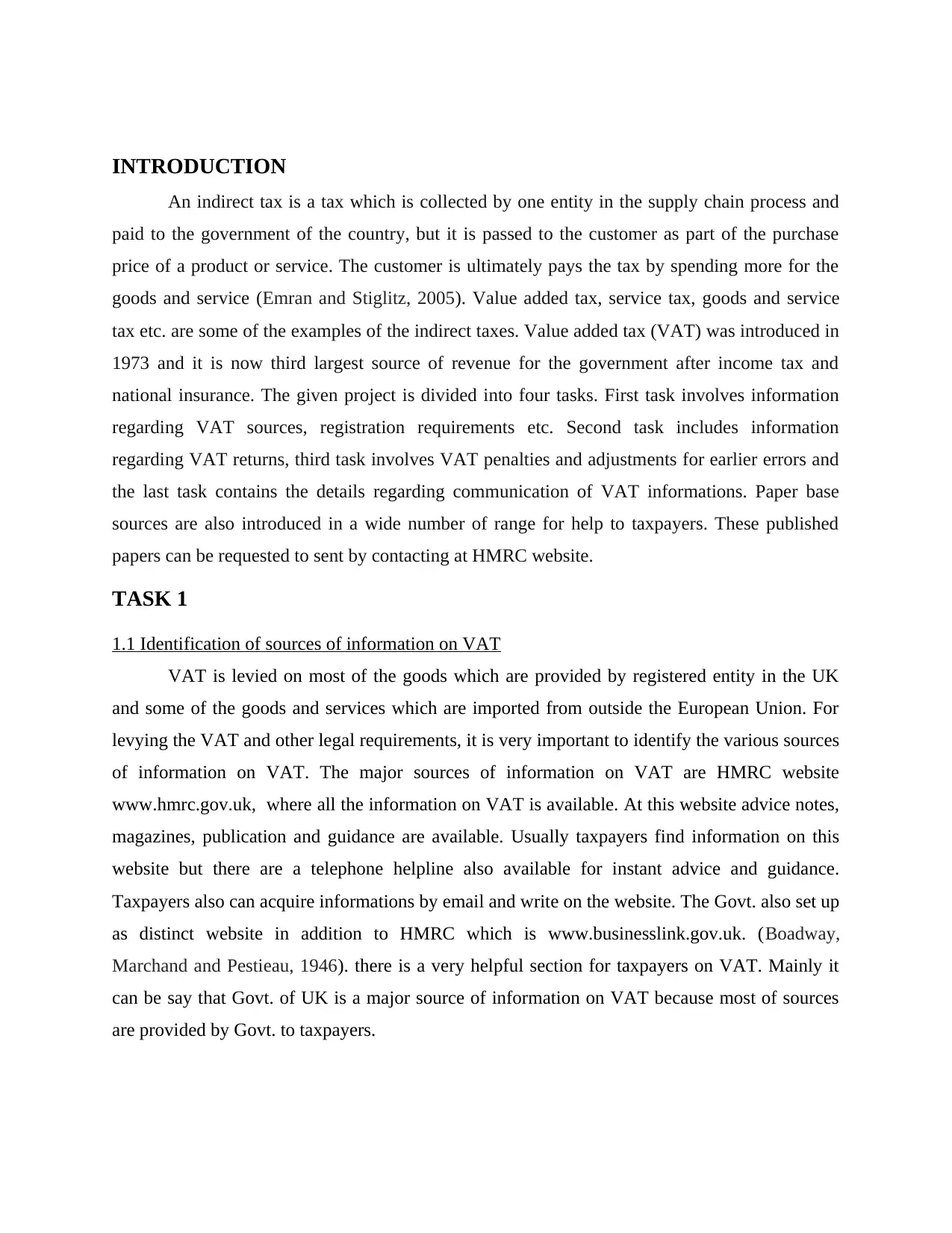
INTRODUCTION
An indirect tax is a tax which is collected by one entity in the supply chain process and
paid to the government of the country, but it is passed to the customer as part of the purchase
price of a product or service. The customer is ultimately pays the tax by spending more for the
goods and service (Emran and Stiglitz, 2005). Value added tax, service tax, goods and service
tax etc. are some of the examples of the indirect taxes. Value added tax (VAT) was introduced in
1973 and it is now third largest source of revenue for the government after income tax and
national insurance. The given project is divided into four tasks. First task involves information
regarding VAT sources, registration requirements etc. Second task includes information
regarding VAT returns, third task involves VAT penalties and adjustments for earlier errors and
the last task contains the details regarding communication of VAT informations. Paper base
sources are also introduced in a wide number of range for help to taxpayers. These published
papers can be requested to sent by contacting at HMRC website.
TASK 1
1.1 Identification of sources of information on VAT
VAT is levied on most of the goods which are provided by registered entity in the UK
and some of the goods and services which are imported from outside the European Union. For
levying the VAT and other legal requirements, it is very important to identify the various sources
of information on VAT. The major sources of information on VAT are HMRC website
www.hmrc.gov.uk, where all the information on VAT is available. At this website advice notes,
magazines, publication and guidance are available. Usually taxpayers find information on this
website but there are a telephone helpline also available for instant advice and guidance.
Taxpayers also can acquire informations by email and write on the website. The Govt. also set up
as distinct website in addition to HMRC which is www.businesslink.gov.uk. (Boadway,
Marchand and Pestieau, 1946). there is a very helpful section for taxpayers on VAT. Mainly it
can be say that Govt. of UK is a major source of information on VAT because most of sources
are provided by Govt. to taxpayers.
An indirect tax is a tax which is collected by one entity in the supply chain process and
paid to the government of the country, but it is passed to the customer as part of the purchase
price of a product or service. The customer is ultimately pays the tax by spending more for the
goods and service (Emran and Stiglitz, 2005). Value added tax, service tax, goods and service
tax etc. are some of the examples of the indirect taxes. Value added tax (VAT) was introduced in
1973 and it is now third largest source of revenue for the government after income tax and
national insurance. The given project is divided into four tasks. First task involves information
regarding VAT sources, registration requirements etc. Second task includes information
regarding VAT returns, third task involves VAT penalties and adjustments for earlier errors and
the last task contains the details regarding communication of VAT informations. Paper base
sources are also introduced in a wide number of range for help to taxpayers. These published
papers can be requested to sent by contacting at HMRC website.
TASK 1
1.1 Identification of sources of information on VAT
VAT is levied on most of the goods which are provided by registered entity in the UK
and some of the goods and services which are imported from outside the European Union. For
levying the VAT and other legal requirements, it is very important to identify the various sources
of information on VAT. The major sources of information on VAT are HMRC website
www.hmrc.gov.uk, where all the information on VAT is available. At this website advice notes,
magazines, publication and guidance are available. Usually taxpayers find information on this
website but there are a telephone helpline also available for instant advice and guidance.
Taxpayers also can acquire informations by email and write on the website. The Govt. also set up
as distinct website in addition to HMRC which is www.businesslink.gov.uk. (Boadway,
Marchand and Pestieau, 1946). there is a very helpful section for taxpayers on VAT. Mainly it
can be say that Govt. of UK is a major source of information on VAT because most of sources
are provided by Govt. to taxpayers.
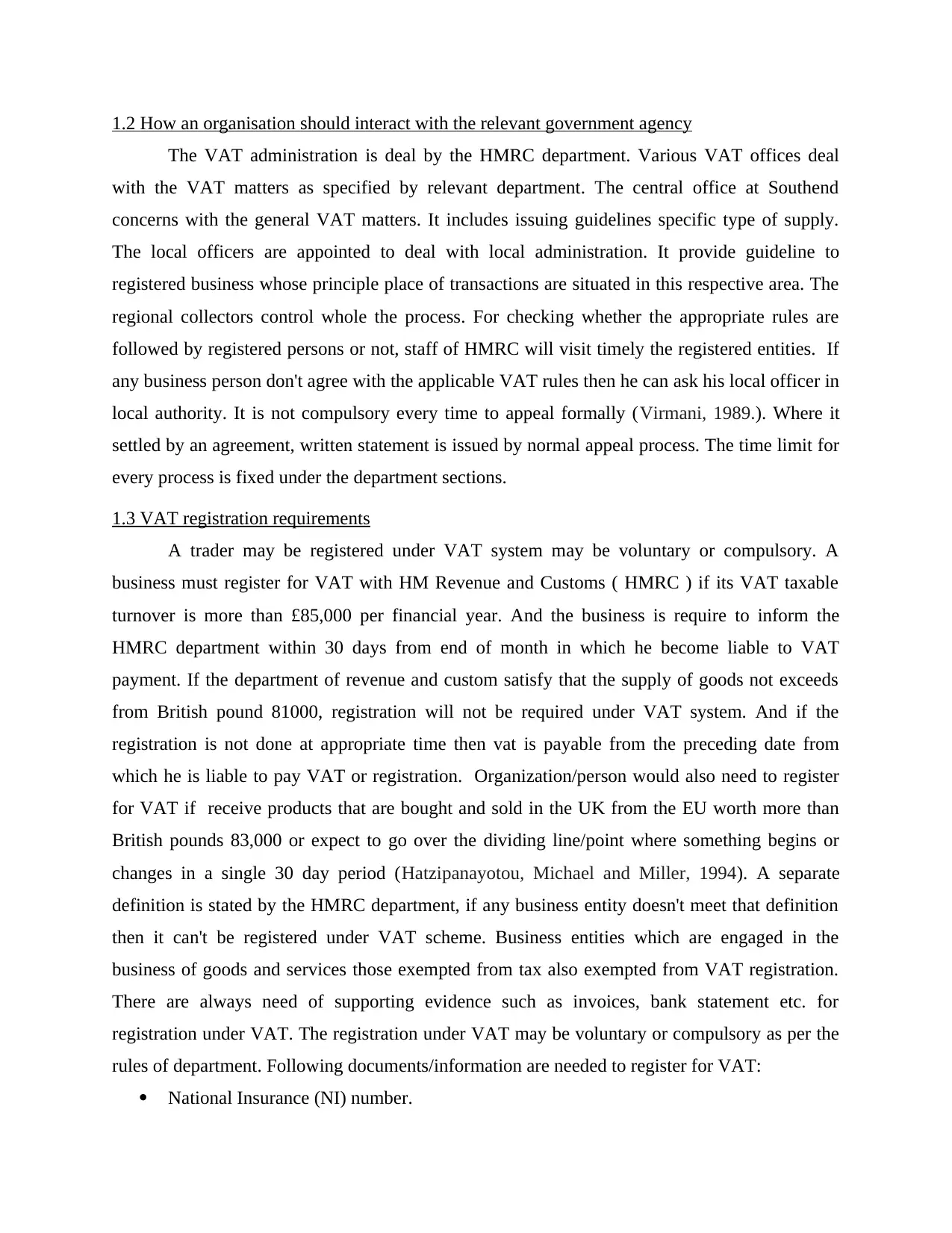
1.2 How an organisation should interact with the relevant government agency
The VAT administration is deal by the HMRC department. Various VAT offices deal
with the VAT matters as specified by relevant department. The central office at Southend
concerns with the general VAT matters. It includes issuing guidelines specific type of supply.
The local officers are appointed to deal with local administration. It provide guideline to
registered business whose principle place of transactions are situated in this respective area. The
regional collectors control whole the process. For checking whether the appropriate rules are
followed by registered persons or not, staff of HMRC will visit timely the registered entities. If
any business person don't agree with the applicable VAT rules then he can ask his local officer in
local authority. It is not compulsory every time to appeal formally (Virmani, 1989.). Where it
settled by an agreement, written statement is issued by normal appeal process. The time limit for
every process is fixed under the department sections.
1.3 VAT registration requirements
A trader may be registered under VAT system may be voluntary or compulsory. A
business must register for VAT with HM Revenue and Customs ( HMRC ) if its VAT taxable
turnover is more than £85,000 per financial year. And the business is require to inform the
HMRC department within 30 days from end of month in which he become liable to VAT
payment. If the department of revenue and custom satisfy that the supply of goods not exceeds
from British pound 81000, registration will not be required under VAT system. And if the
registration is not done at appropriate time then vat is payable from the preceding date from
which he is liable to pay VAT or registration. Organization/person would also need to register
for VAT if receive products that are bought and sold in the UK from the EU worth more than
British pounds 83,000 or expect to go over the dividing line/point where something begins or
changes in a single 30 day period (Hatzipanayotou, Michael and Miller, 1994). A separate
definition is stated by the HMRC department, if any business entity doesn't meet that definition
then it can't be registered under VAT scheme. Business entities which are engaged in the
business of goods and services those exempted from tax also exempted from VAT registration.
There are always need of supporting evidence such as invoices, bank statement etc. for
registration under VAT. The registration under VAT may be voluntary or compulsory as per the
rules of department. Following documents/information are needed to register for VAT:
National Insurance (NI) number.
The VAT administration is deal by the HMRC department. Various VAT offices deal
with the VAT matters as specified by relevant department. The central office at Southend
concerns with the general VAT matters. It includes issuing guidelines specific type of supply.
The local officers are appointed to deal with local administration. It provide guideline to
registered business whose principle place of transactions are situated in this respective area. The
regional collectors control whole the process. For checking whether the appropriate rules are
followed by registered persons or not, staff of HMRC will visit timely the registered entities. If
any business person don't agree with the applicable VAT rules then he can ask his local officer in
local authority. It is not compulsory every time to appeal formally (Virmani, 1989.). Where it
settled by an agreement, written statement is issued by normal appeal process. The time limit for
every process is fixed under the department sections.
1.3 VAT registration requirements
A trader may be registered under VAT system may be voluntary or compulsory. A
business must register for VAT with HM Revenue and Customs ( HMRC ) if its VAT taxable
turnover is more than £85,000 per financial year. And the business is require to inform the
HMRC department within 30 days from end of month in which he become liable to VAT
payment. If the department of revenue and custom satisfy that the supply of goods not exceeds
from British pound 81000, registration will not be required under VAT system. And if the
registration is not done at appropriate time then vat is payable from the preceding date from
which he is liable to pay VAT or registration. Organization/person would also need to register
for VAT if receive products that are bought and sold in the UK from the EU worth more than
British pounds 83,000 or expect to go over the dividing line/point where something begins or
changes in a single 30 day period (Hatzipanayotou, Michael and Miller, 1994). A separate
definition is stated by the HMRC department, if any business entity doesn't meet that definition
then it can't be registered under VAT scheme. Business entities which are engaged in the
business of goods and services those exempted from tax also exempted from VAT registration.
There are always need of supporting evidence such as invoices, bank statement etc. for
registration under VAT. The registration under VAT may be voluntary or compulsory as per the
rules of department. Following documents/information are needed to register for VAT:
National Insurance (NI) number.
Secure Best Marks with AI Grader
Need help grading? Try our AI Grader for instant feedback on your assignments.
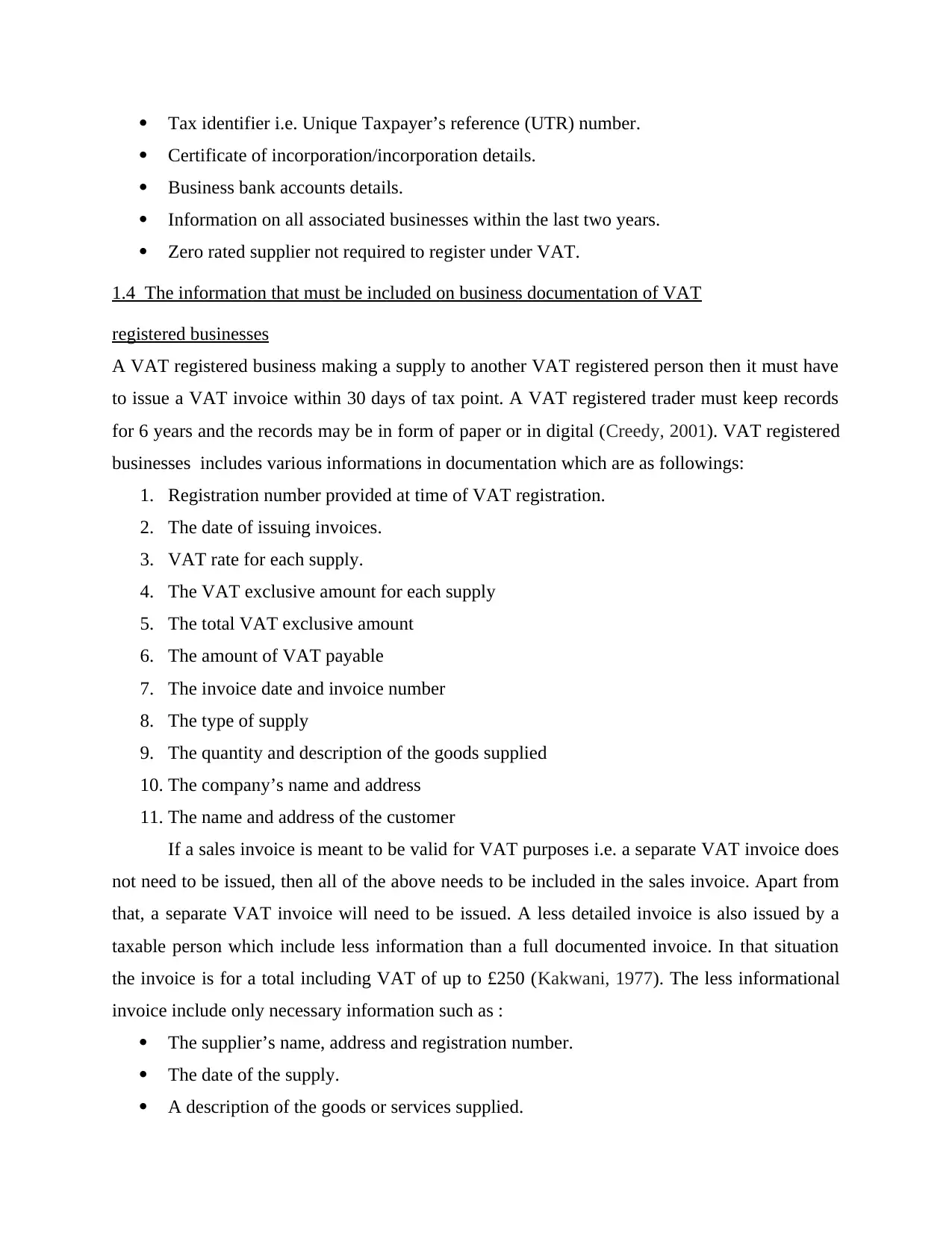
Tax identifier i.e. Unique Taxpayer’s reference (UTR) number.
Certificate of incorporation/incorporation details.
Business bank accounts details.
Information on all associated businesses within the last two years.
Zero rated supplier not required to register under VAT.
1.4 The information that must be included on business documentation of VAT
registered businesses
A VAT registered business making a supply to another VAT registered person then it must have
to issue a VAT invoice within 30 days of tax point. A VAT registered trader must keep records
for 6 years and the records may be in form of paper or in digital (Creedy, 2001). VAT registered
businesses includes various informations in documentation which are as followings:
1. Registration number provided at time of VAT registration.
2. The date of issuing invoices.
3. VAT rate for each supply.
4. The VAT exclusive amount for each supply
5. The total VAT exclusive amount
6. The amount of VAT payable
7. The invoice date and invoice number
8. The type of supply
9. The quantity and description of the goods supplied
10. The company’s name and address
11. The name and address of the customer
If a sales invoice is meant to be valid for VAT purposes i.e. a separate VAT invoice does
not need to be issued, then all of the above needs to be included in the sales invoice. Apart from
that, a separate VAT invoice will need to be issued. A less detailed invoice is also issued by a
taxable person which include less information than a full documented invoice. In that situation
the invoice is for a total including VAT of up to £250 (Kakwani, 1977). The less informational
invoice include only necessary information such as :
The supplier’s name, address and registration number.
The date of the supply.
A description of the goods or services supplied.
Certificate of incorporation/incorporation details.
Business bank accounts details.
Information on all associated businesses within the last two years.
Zero rated supplier not required to register under VAT.
1.4 The information that must be included on business documentation of VAT
registered businesses
A VAT registered business making a supply to another VAT registered person then it must have
to issue a VAT invoice within 30 days of tax point. A VAT registered trader must keep records
for 6 years and the records may be in form of paper or in digital (Creedy, 2001). VAT registered
businesses includes various informations in documentation which are as followings:
1. Registration number provided at time of VAT registration.
2. The date of issuing invoices.
3. VAT rate for each supply.
4. The VAT exclusive amount for each supply
5. The total VAT exclusive amount
6. The amount of VAT payable
7. The invoice date and invoice number
8. The type of supply
9. The quantity and description of the goods supplied
10. The company’s name and address
11. The name and address of the customer
If a sales invoice is meant to be valid for VAT purposes i.e. a separate VAT invoice does
not need to be issued, then all of the above needs to be included in the sales invoice. Apart from
that, a separate VAT invoice will need to be issued. A less detailed invoice is also issued by a
taxable person which include less information than a full documented invoice. In that situation
the invoice is for a total including VAT of up to £250 (Kakwani, 1977). The less informational
invoice include only necessary information such as :
The supplier’s name, address and registration number.
The date of the supply.
A description of the goods or services supplied.
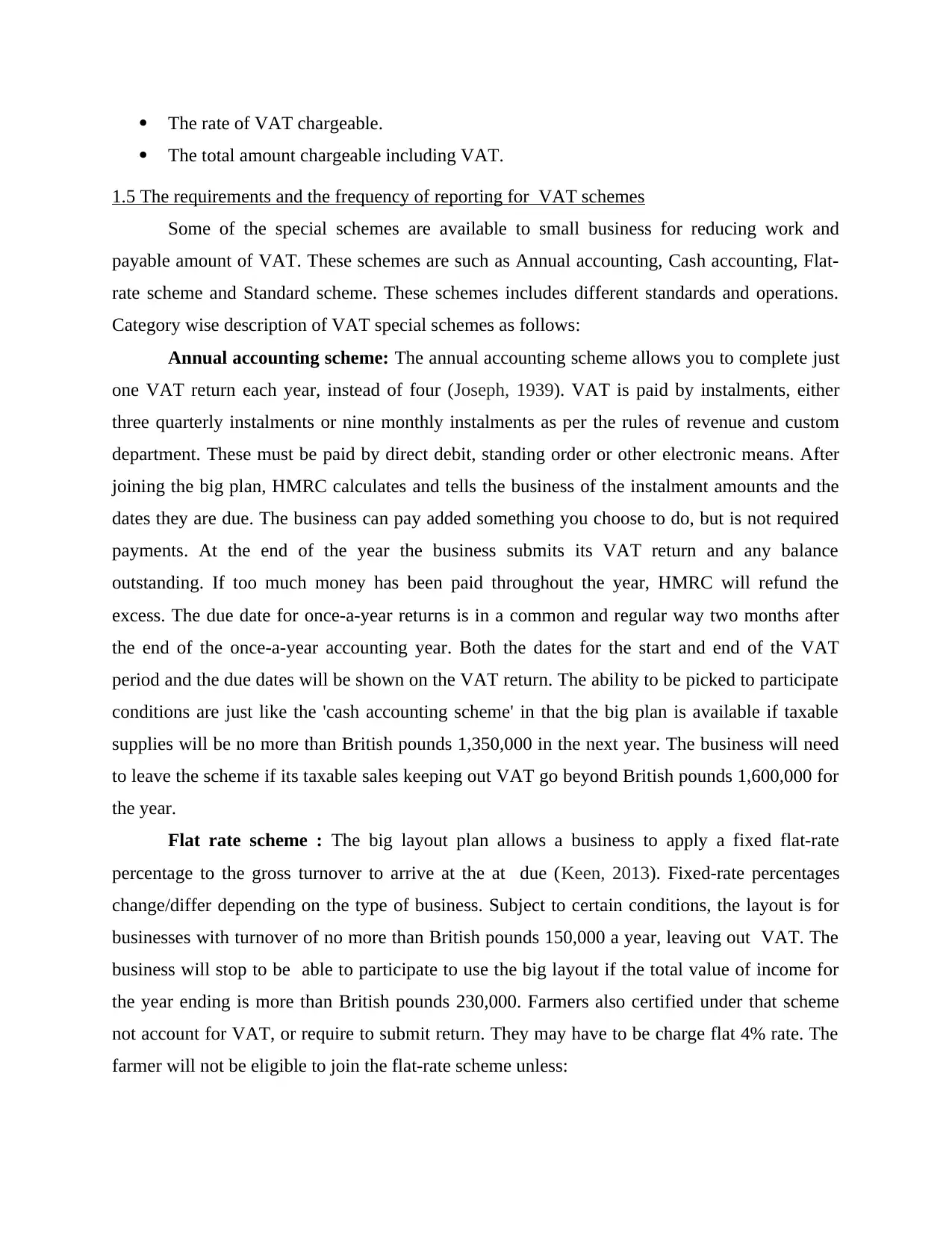
The rate of VAT chargeable.
The total amount chargeable including VAT.
1.5 The requirements and the frequency of reporting for VAT schemes
Some of the special schemes are available to small business for reducing work and
payable amount of VAT. These schemes are such as Annual accounting, Cash accounting, Flat-
rate scheme and Standard scheme. These schemes includes different standards and operations.
Category wise description of VAT special schemes as follows:
Annual accounting scheme: The annual accounting scheme allows you to complete just
one VAT return each year, instead of four (Joseph, 1939). VAT is paid by instalments, either
three quarterly instalments or nine monthly instalments as per the rules of revenue and custom
department. These must be paid by direct debit, standing order or other electronic means. After
joining the big plan, HMRC calculates and tells the business of the instalment amounts and the
dates they are due. The business can pay added something you choose to do, but is not required
payments. At the end of the year the business submits its VAT return and any balance
outstanding. If too much money has been paid throughout the year, HMRC will refund the
excess. The due date for once-a-year returns is in a common and regular way two months after
the end of the once-a-year accounting year. Both the dates for the start and end of the VAT
period and the due dates will be shown on the VAT return. The ability to be picked to participate
conditions are just like the 'cash accounting scheme' in that the big plan is available if taxable
supplies will be no more than British pounds 1,350,000 in the next year. The business will need
to leave the scheme if its taxable sales keeping out VAT go beyond British pounds 1,600,000 for
the year.
Flat rate scheme : The big layout plan allows a business to apply a fixed flat-rate
percentage to the gross turnover to arrive at the at due (Keen, 2013). Fixed-rate percentages
change/differ depending on the type of business. Subject to certain conditions, the layout is for
businesses with turnover of no more than British pounds 150,000 a year, leaving out VAT. The
business will stop to be able to participate to use the big layout if the total value of income for
the year ending is more than British pounds 230,000. Farmers also certified under that scheme
not account for VAT, or require to submit return. They may have to be charge flat 4% rate. The
farmer will not be eligible to join the flat-rate scheme unless:
The total amount chargeable including VAT.
1.5 The requirements and the frequency of reporting for VAT schemes
Some of the special schemes are available to small business for reducing work and
payable amount of VAT. These schemes are such as Annual accounting, Cash accounting, Flat-
rate scheme and Standard scheme. These schemes includes different standards and operations.
Category wise description of VAT special schemes as follows:
Annual accounting scheme: The annual accounting scheme allows you to complete just
one VAT return each year, instead of four (Joseph, 1939). VAT is paid by instalments, either
three quarterly instalments or nine monthly instalments as per the rules of revenue and custom
department. These must be paid by direct debit, standing order or other electronic means. After
joining the big plan, HMRC calculates and tells the business of the instalment amounts and the
dates they are due. The business can pay added something you choose to do, but is not required
payments. At the end of the year the business submits its VAT return and any balance
outstanding. If too much money has been paid throughout the year, HMRC will refund the
excess. The due date for once-a-year returns is in a common and regular way two months after
the end of the once-a-year accounting year. Both the dates for the start and end of the VAT
period and the due dates will be shown on the VAT return. The ability to be picked to participate
conditions are just like the 'cash accounting scheme' in that the big plan is available if taxable
supplies will be no more than British pounds 1,350,000 in the next year. The business will need
to leave the scheme if its taxable sales keeping out VAT go beyond British pounds 1,600,000 for
the year.
Flat rate scheme : The big layout plan allows a business to apply a fixed flat-rate
percentage to the gross turnover to arrive at the at due (Keen, 2013). Fixed-rate percentages
change/differ depending on the type of business. Subject to certain conditions, the layout is for
businesses with turnover of no more than British pounds 150,000 a year, leaving out VAT. The
business will stop to be able to participate to use the big layout if the total value of income for
the year ending is more than British pounds 230,000. Farmers also certified under that scheme
not account for VAT, or require to submit return. They may have to be charge flat 4% rate. The
farmer will not be eligible to join the flat-rate scheme unless:

The non-farming activities are zero-rated, in which case the farmer may ask for
exemption from registration and join the scheme; or
The non-farming business is run as a separate business by a different legal entity e.g. a
person could run his farming activities as a sole proprietor and a bed and breakfast
business in partnership with another person.
Standard scheme: Under this scheme VAT is paid on the time when invoices are issued.
VAT return is filled four times per year under that scheme (FitzGerald, Johnston and Williams,
1995). VAT amount is calculate for payment by comparing the VAT due on the cost and owed
on sales volume. HMRC will refund and acquire the due VAT amount after comparing the above
terms.
1.6 Maintain an up-to-date knowledge of changes to codes of practice, regulation or legislation
Maintaining an up to date knowledge of changes to code of practice, regulations or
legislation will help the business organization at a wider context. HMRC announces various
changes VAT regulation and legislation, some of are as follows:
Digital records maintenance will be compulsory for VAT calculation, manual records
are not further valid. So if a businesses organization keep it in consideration with up to
date then it have to very easy to face challenges in future.
Changes are announced in VAT return submission that returns must be submitted to
HMRC by means of a business’s functional compatible software communicating
digitally via HMRC’s API platform, and not by manually entering the VAT return
figures onto the HMRC portal. So VAT registered business organization must be
considered this upcoming change so that in future return can be submitted very easily
and without any errors.
TASK 2
2.1 Extraction of relevant data for a specific period from accounting records
VAT returns can be submitted either monthly or quarterly in In the UK. Most of the
returns are filled on a quarterly basis. Once registered, a business will be assigned to a “VAT
stagger group”. Let us assume stagger group on which quarters ends on March, June, September
and December. Following are the details for the extraction of relevant data for filing the return of
the VAT for the quarter ending 31st December, 2018:
exemption from registration and join the scheme; or
The non-farming business is run as a separate business by a different legal entity e.g. a
person could run his farming activities as a sole proprietor and a bed and breakfast
business in partnership with another person.
Standard scheme: Under this scheme VAT is paid on the time when invoices are issued.
VAT return is filled four times per year under that scheme (FitzGerald, Johnston and Williams,
1995). VAT amount is calculate for payment by comparing the VAT due on the cost and owed
on sales volume. HMRC will refund and acquire the due VAT amount after comparing the above
terms.
1.6 Maintain an up-to-date knowledge of changes to codes of practice, regulation or legislation
Maintaining an up to date knowledge of changes to code of practice, regulations or
legislation will help the business organization at a wider context. HMRC announces various
changes VAT regulation and legislation, some of are as follows:
Digital records maintenance will be compulsory for VAT calculation, manual records
are not further valid. So if a businesses organization keep it in consideration with up to
date then it have to very easy to face challenges in future.
Changes are announced in VAT return submission that returns must be submitted to
HMRC by means of a business’s functional compatible software communicating
digitally via HMRC’s API platform, and not by manually entering the VAT return
figures onto the HMRC portal. So VAT registered business organization must be
considered this upcoming change so that in future return can be submitted very easily
and without any errors.
TASK 2
2.1 Extraction of relevant data for a specific period from accounting records
VAT returns can be submitted either monthly or quarterly in In the UK. Most of the
returns are filled on a quarterly basis. Once registered, a business will be assigned to a “VAT
stagger group”. Let us assume stagger group on which quarters ends on March, June, September
and December. Following are the details for the extraction of relevant data for filing the return of
the VAT for the quarter ending 31st December, 2018:
Paraphrase This Document
Need a fresh take? Get an instant paraphrase of this document with our AI Paraphraser

Accounting Information
For VAT payable:
Sales Book £ 256658
Less: Credit Note £ 2762
Total £ 253896
Cash Book £ 9858
EU Acquisitions £ 21630
Correction of error £ 1763
Grand Total £ 287147
For Input VAT:
Purchase Book £115680
Less: Credit Notes £ 1860
Total £ 113820
Cash Book £ 7950
Petty Cash Book £160
EU Acquisitions £ 23650
Bad Debt Relief £ 6960
Grand Total £ 152540
2.2 Relevant inputs and outputs using these VAT classifications
VAT payable:
Sales Sales Value (£) VAT Payable (£)
Standard Supplies 180600 17835.5
Exempt Supplies 25450 -
Zero Rated Supplies 30900 -
Exports 16946 -
Sales Book £ 18110.50
Less: Credit Note £ 275.00
Total £ 17835.50
Cash Book £ 960.50
For VAT payable:
Sales Book £ 256658
Less: Credit Note £ 2762
Total £ 253896
Cash Book £ 9858
EU Acquisitions £ 21630
Correction of error £ 1763
Grand Total £ 287147
For Input VAT:
Purchase Book £115680
Less: Credit Notes £ 1860
Total £ 113820
Cash Book £ 7950
Petty Cash Book £160
EU Acquisitions £ 23650
Bad Debt Relief £ 6960
Grand Total £ 152540
2.2 Relevant inputs and outputs using these VAT classifications
VAT payable:
Sales Sales Value (£) VAT Payable (£)
Standard Supplies 180600 17835.5
Exempt Supplies 25450 -
Zero Rated Supplies 30900 -
Exports 16946 -
Sales Book £ 18110.50
Less: Credit Note £ 275.00
Total £ 17835.50
Cash Book £ 960.50
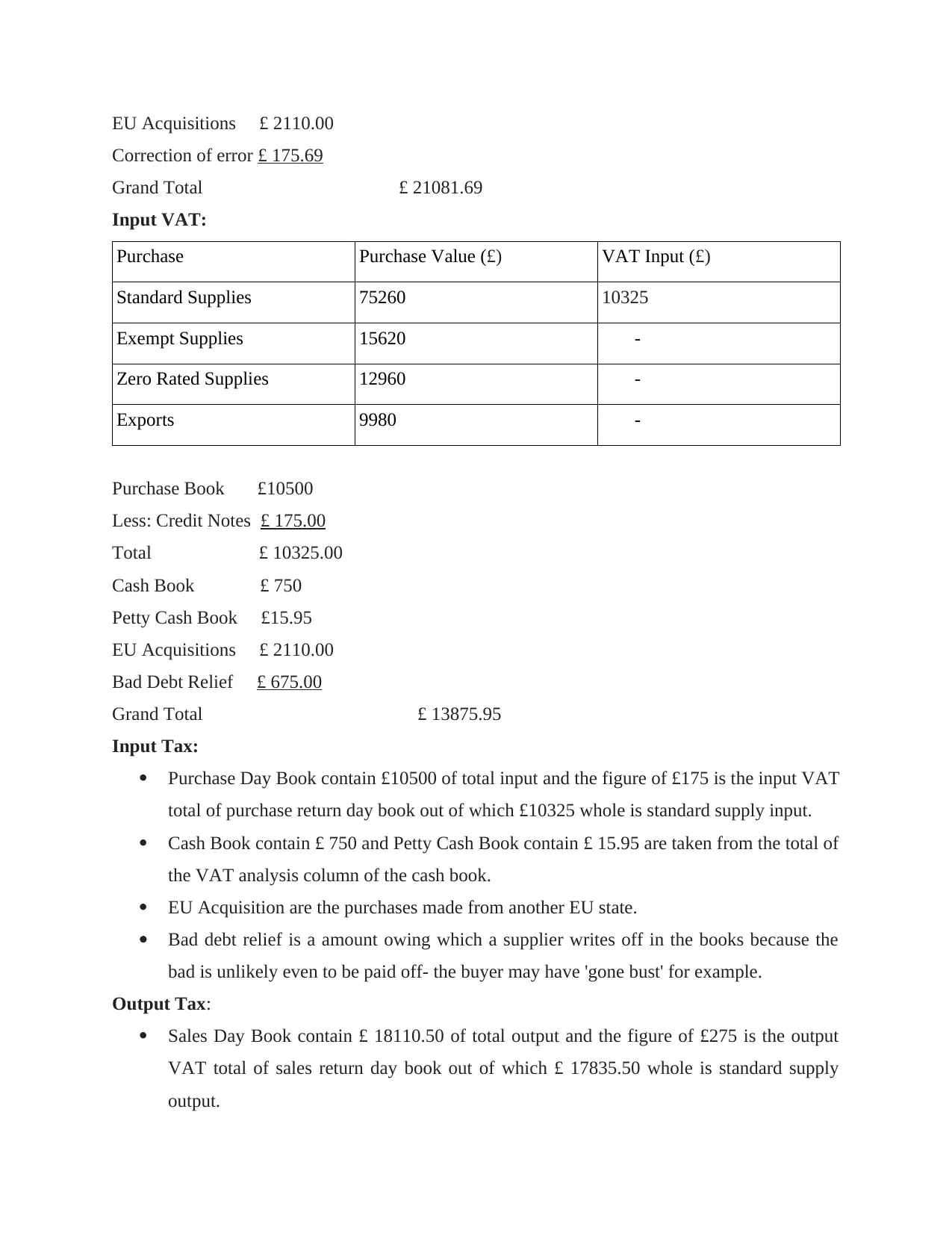
EU Acquisitions £ 2110.00
Correction of error £ 175.69
Grand Total £ 21081.69
Input VAT:
Purchase Purchase Value (£) VAT Input (£)
Standard Supplies 75260 10325
Exempt Supplies 15620 -
Zero Rated Supplies 12960 -
Exports 9980 -
Purchase Book £10500
Less: Credit Notes £ 175.00
Total £ 10325.00
Cash Book £ 750
Petty Cash Book £15.95
EU Acquisitions £ 2110.00
Bad Debt Relief £ 675.00
Grand Total £ 13875.95
Input Tax:
Purchase Day Book contain £10500 of total input and the figure of £175 is the input VAT
total of purchase return day book out of which £10325 whole is standard supply input.
Cash Book contain £ 750 and Petty Cash Book contain £ 15.95 are taken from the total of
the VAT analysis column of the cash book.
EU Acquisition are the purchases made from another EU state.
Bad debt relief is a amount owing which a supplier writes off in the books because the
bad is unlikely even to be paid off- the buyer may have 'gone bust' for example.
Output Tax:
Sales Day Book contain £ 18110.50 of total output and the figure of £275 is the output
VAT total of sales return day book out of which £ 17835.50 whole is standard supply
output.
Correction of error £ 175.69
Grand Total £ 21081.69
Input VAT:
Purchase Purchase Value (£) VAT Input (£)
Standard Supplies 75260 10325
Exempt Supplies 15620 -
Zero Rated Supplies 12960 -
Exports 9980 -
Purchase Book £10500
Less: Credit Notes £ 175.00
Total £ 10325.00
Cash Book £ 750
Petty Cash Book £15.95
EU Acquisitions £ 2110.00
Bad Debt Relief £ 675.00
Grand Total £ 13875.95
Input Tax:
Purchase Day Book contain £10500 of total input and the figure of £175 is the input VAT
total of purchase return day book out of which £10325 whole is standard supply input.
Cash Book contain £ 750 and Petty Cash Book contain £ 15.95 are taken from the total of
the VAT analysis column of the cash book.
EU Acquisition are the purchases made from another EU state.
Bad debt relief is a amount owing which a supplier writes off in the books because the
bad is unlikely even to be paid off- the buyer may have 'gone bust' for example.
Output Tax:
Sales Day Book contain £ 18110.50 of total output and the figure of £275 is the output
VAT total of sales return day book out of which £ 17835.50 whole is standard supply
output.
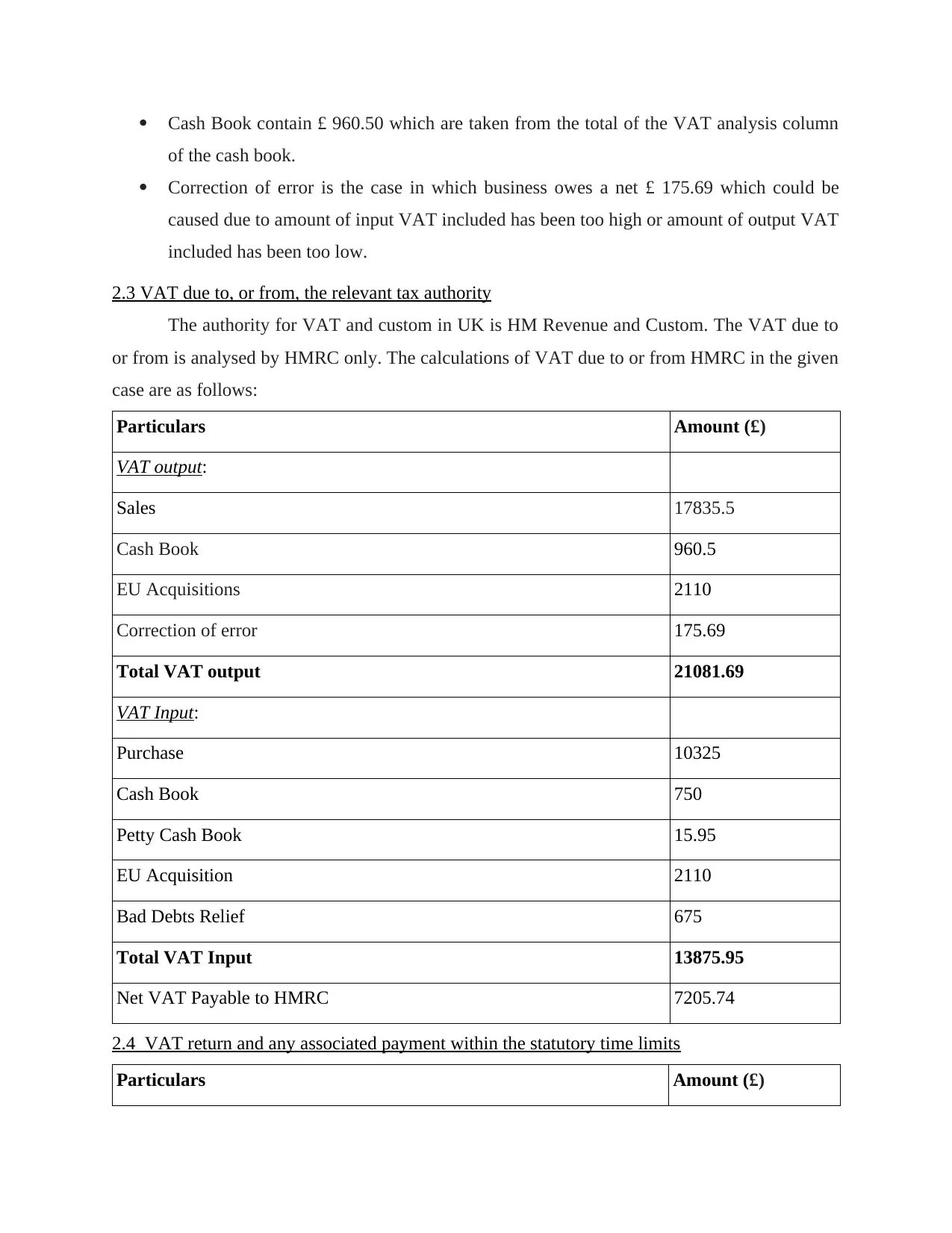
Cash Book contain £ 960.50 which are taken from the total of the VAT analysis column
of the cash book.
Correction of error is the case in which business owes a net £ 175.69 which could be
caused due to amount of input VAT included has been too high or amount of output VAT
included has been too low.
2.3 VAT due to, or from, the relevant tax authority
The authority for VAT and custom in UK is HM Revenue and Custom. The VAT due to
or from is analysed by HMRC only. The calculations of VAT due to or from HMRC in the given
case are as follows:
Particulars Amount (£)
VAT output:
Sales 17835.5
Cash Book 960.5
EU Acquisitions 2110
Correction of error 175.69
Total VAT output 21081.69
VAT Input:
Purchase 10325
Cash Book 750
Petty Cash Book 15.95
EU Acquisition 2110
Bad Debts Relief 675
Total VAT Input 13875.95
Net VAT Payable to HMRC 7205.74
2.4 VAT return and any associated payment within the statutory time limits
Particulars Amount (£)
of the cash book.
Correction of error is the case in which business owes a net £ 175.69 which could be
caused due to amount of input VAT included has been too high or amount of output VAT
included has been too low.
2.3 VAT due to, or from, the relevant tax authority
The authority for VAT and custom in UK is HM Revenue and Custom. The VAT due to
or from is analysed by HMRC only. The calculations of VAT due to or from HMRC in the given
case are as follows:
Particulars Amount (£)
VAT output:
Sales 17835.5
Cash Book 960.5
EU Acquisitions 2110
Correction of error 175.69
Total VAT output 21081.69
VAT Input:
Purchase 10325
Cash Book 750
Petty Cash Book 15.95
EU Acquisition 2110
Bad Debts Relief 675
Total VAT Input 13875.95
Net VAT Payable to HMRC 7205.74
2.4 VAT return and any associated payment within the statutory time limits
Particulars Amount (£)
Secure Best Marks with AI Grader
Need help grading? Try our AI Grader for instant feedback on your assignments.

VAT due in on sales 18971.69
VAT due on acquisitions from other EC Member State 2110
Total VAT due 21081.69
VAT input including acquisitions from the EC 13875.95
Net VAT to be paid to HMRC 7205.74
Total value of sales and all other output 256658
Total value of purchases and all other input 113820
Total value of all supplies of goods and related costs, excluding any
VAT, to other EC Member States
265517
Total value of all acquisitions of goods and related costs, excluding any
VAT, from other EC Member States
128890
Return for the quarter ended 31st December 2018 will have to submit to HMRC till 7th
February, 2019 and the payment of £ 7205.74 is also required to pay till 7th February, 2019
otherwise penalties will have to be paid by the organization.
TASK 3
3.1 The implications and penalties for an organisation resulting from failure to abide by VAT
regulations
The department of HM revenue and custom impose various penalties and surcharges for
default (Kanbur and Keen, 1991). These are based on some specific conditions. HMRC record a
default on following conditions if:
it don't receive VAT return by timely.
If the full payment is not done by the deadline.
Surcharges: A VAT registered business may enter a 12 month surcharge period if make
default during this time:
surcharge period may be extended for a further 12 months
have to be pay extra surcharge.
VAT due on acquisitions from other EC Member State 2110
Total VAT due 21081.69
VAT input including acquisitions from the EC 13875.95
Net VAT to be paid to HMRC 7205.74
Total value of sales and all other output 256658
Total value of purchases and all other input 113820
Total value of all supplies of goods and related costs, excluding any
VAT, to other EC Member States
265517
Total value of all acquisitions of goods and related costs, excluding any
VAT, from other EC Member States
128890
Return for the quarter ended 31st December 2018 will have to submit to HMRC till 7th
February, 2019 and the payment of £ 7205.74 is also required to pay till 7th February, 2019
otherwise penalties will have to be paid by the organization.
TASK 3
3.1 The implications and penalties for an organisation resulting from failure to abide by VAT
regulations
The department of HM revenue and custom impose various penalties and surcharges for
default (Kanbur and Keen, 1991). These are based on some specific conditions. HMRC record a
default on following conditions if:
it don't receive VAT return by timely.
If the full payment is not done by the deadline.
Surcharges: A VAT registered business may enter a 12 month surcharge period if make
default during this time:
surcharge period may be extended for a further 12 months
have to be pay extra surcharge.

If some time late return is filled then surcharge not imposed in some specific cases such
as vat pay in full timely, due a repayment. Surcharge is not applicable for first default. With in
12 months surcharge rate is fixed for every default according to time.
Penalties: HMRC charge the penalties as follows for making default:
100% of any tax under-stated or over-claimed if you send a return that contains a careless
or deliberate inaccuracy
30% of an assessment if sends you one that’s too low and you do not tell them it’s wrong
within 30 days
£400 if you submit a paper Return, unless has told you you’re exempt from submitting
your return online (VAT Returns. 2019).
3.2 Adjustments and declarations for any errors or omissions identified in previous VAT periods
The errors or omission identified in previous period of VAT then HMRC can charge
penalty for the errors. These errors are divided into various categories. If errors are done
intentionally or due to careless behaviour then decisions will be different from other situation of
making errors. Section 4 deal with the various type of errors and their adjustments after
identifying these in previous periods (Rajemison and Younger, 2000). There are 2 methods
described in the HMRC rules for rectifying errors. These methods are differentiated on the basis
of errors amount.
TASK 4
4.1 Inform managers of the impact that the VAT payment may have on an organisation’s cash
flow and financial forecasts
A business have a wide impact of the VAT payment on cash flow an financial forecast. it
is a substantial payment for every business entity registered under VAT system, so provisions
should be made for the surety of payment in future. If the VAT payment £1.35 million or less
than, then it may pay on the basis of cash received and pay. And payment of VAT effect the flow
of cash in cash flow statement. It will help the managers that payment is not done to HMRC on
invoice. Financial forecast can be done through help of VAT payment, if it will be done in partial
payment then cash flow can't effected at single point and at wide level. So managers must
consider the payment points and amounts for less effected cash flow and financial forecast.
as vat pay in full timely, due a repayment. Surcharge is not applicable for first default. With in
12 months surcharge rate is fixed for every default according to time.
Penalties: HMRC charge the penalties as follows for making default:
100% of any tax under-stated or over-claimed if you send a return that contains a careless
or deliberate inaccuracy
30% of an assessment if sends you one that’s too low and you do not tell them it’s wrong
within 30 days
£400 if you submit a paper Return, unless has told you you’re exempt from submitting
your return online (VAT Returns. 2019).
3.2 Adjustments and declarations for any errors or omissions identified in previous VAT periods
The errors or omission identified in previous period of VAT then HMRC can charge
penalty for the errors. These errors are divided into various categories. If errors are done
intentionally or due to careless behaviour then decisions will be different from other situation of
making errors. Section 4 deal with the various type of errors and their adjustments after
identifying these in previous periods (Rajemison and Younger, 2000). There are 2 methods
described in the HMRC rules for rectifying errors. These methods are differentiated on the basis
of errors amount.
TASK 4
4.1 Inform managers of the impact that the VAT payment may have on an organisation’s cash
flow and financial forecasts
A business have a wide impact of the VAT payment on cash flow an financial forecast. it
is a substantial payment for every business entity registered under VAT system, so provisions
should be made for the surety of payment in future. If the VAT payment £1.35 million or less
than, then it may pay on the basis of cash received and pay. And payment of VAT effect the flow
of cash in cash flow statement. It will help the managers that payment is not done to HMRC on
invoice. Financial forecast can be done through help of VAT payment, if it will be done in partial
payment then cash flow can't effected at single point and at wide level. So managers must
consider the payment points and amounts for less effected cash flow and financial forecast.
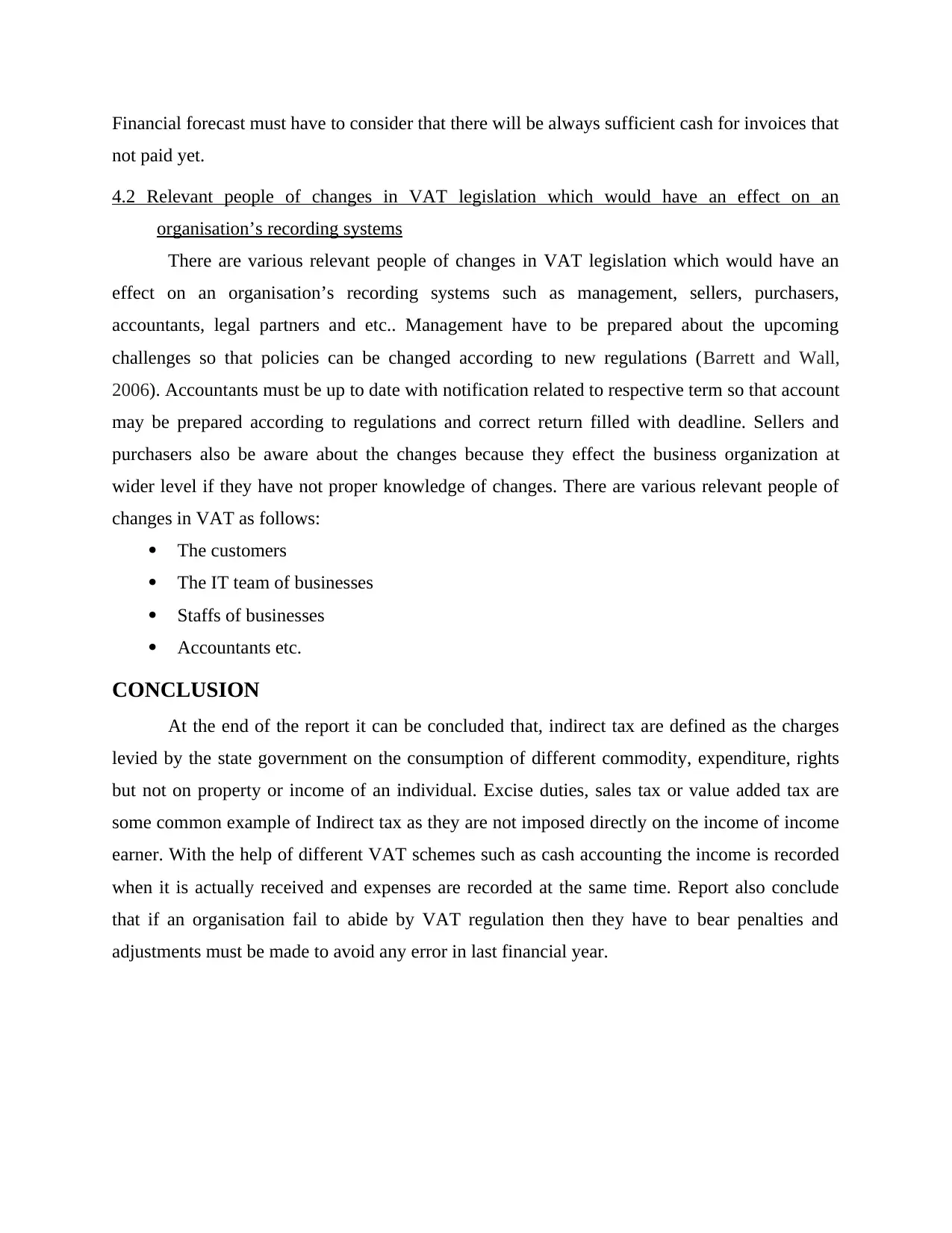
Financial forecast must have to consider that there will be always sufficient cash for invoices that
not paid yet.
4.2 Relevant people of changes in VAT legislation which would have an effect on an
organisation’s recording systems
There are various relevant people of changes in VAT legislation which would have an
effect on an organisation’s recording systems such as management, sellers, purchasers,
accountants, legal partners and etc.. Management have to be prepared about the upcoming
challenges so that policies can be changed according to new regulations (Barrett and Wall,
2006). Accountants must be up to date with notification related to respective term so that account
may be prepared according to regulations and correct return filled with deadline. Sellers and
purchasers also be aware about the changes because they effect the business organization at
wider level if they have not proper knowledge of changes. There are various relevant people of
changes in VAT as follows:
The customers
The IT team of businesses
Staffs of businesses
Accountants etc.
CONCLUSION
At the end of the report it can be concluded that, indirect tax are defined as the charges
levied by the state government on the consumption of different commodity, expenditure, rights
but not on property or income of an individual. Excise duties, sales tax or value added tax are
some common example of Indirect tax as they are not imposed directly on the income of income
earner. With the help of different VAT schemes such as cash accounting the income is recorded
when it is actually received and expenses are recorded at the same time. Report also conclude
that if an organisation fail to abide by VAT regulation then they have to bear penalties and
adjustments must be made to avoid any error in last financial year.
not paid yet.
4.2 Relevant people of changes in VAT legislation which would have an effect on an
organisation’s recording systems
There are various relevant people of changes in VAT legislation which would have an
effect on an organisation’s recording systems such as management, sellers, purchasers,
accountants, legal partners and etc.. Management have to be prepared about the upcoming
challenges so that policies can be changed according to new regulations (Barrett and Wall,
2006). Accountants must be up to date with notification related to respective term so that account
may be prepared according to regulations and correct return filled with deadline. Sellers and
purchasers also be aware about the changes because they effect the business organization at
wider level if they have not proper knowledge of changes. There are various relevant people of
changes in VAT as follows:
The customers
The IT team of businesses
Staffs of businesses
Accountants etc.
CONCLUSION
At the end of the report it can be concluded that, indirect tax are defined as the charges
levied by the state government on the consumption of different commodity, expenditure, rights
but not on property or income of an individual. Excise duties, sales tax or value added tax are
some common example of Indirect tax as they are not imposed directly on the income of income
earner. With the help of different VAT schemes such as cash accounting the income is recorded
when it is actually received and expenses are recorded at the same time. Report also conclude
that if an organisation fail to abide by VAT regulation then they have to bear penalties and
adjustments must be made to avoid any error in last financial year.
Paraphrase This Document
Need a fresh take? Get an instant paraphrase of this document with our AI Paraphraser
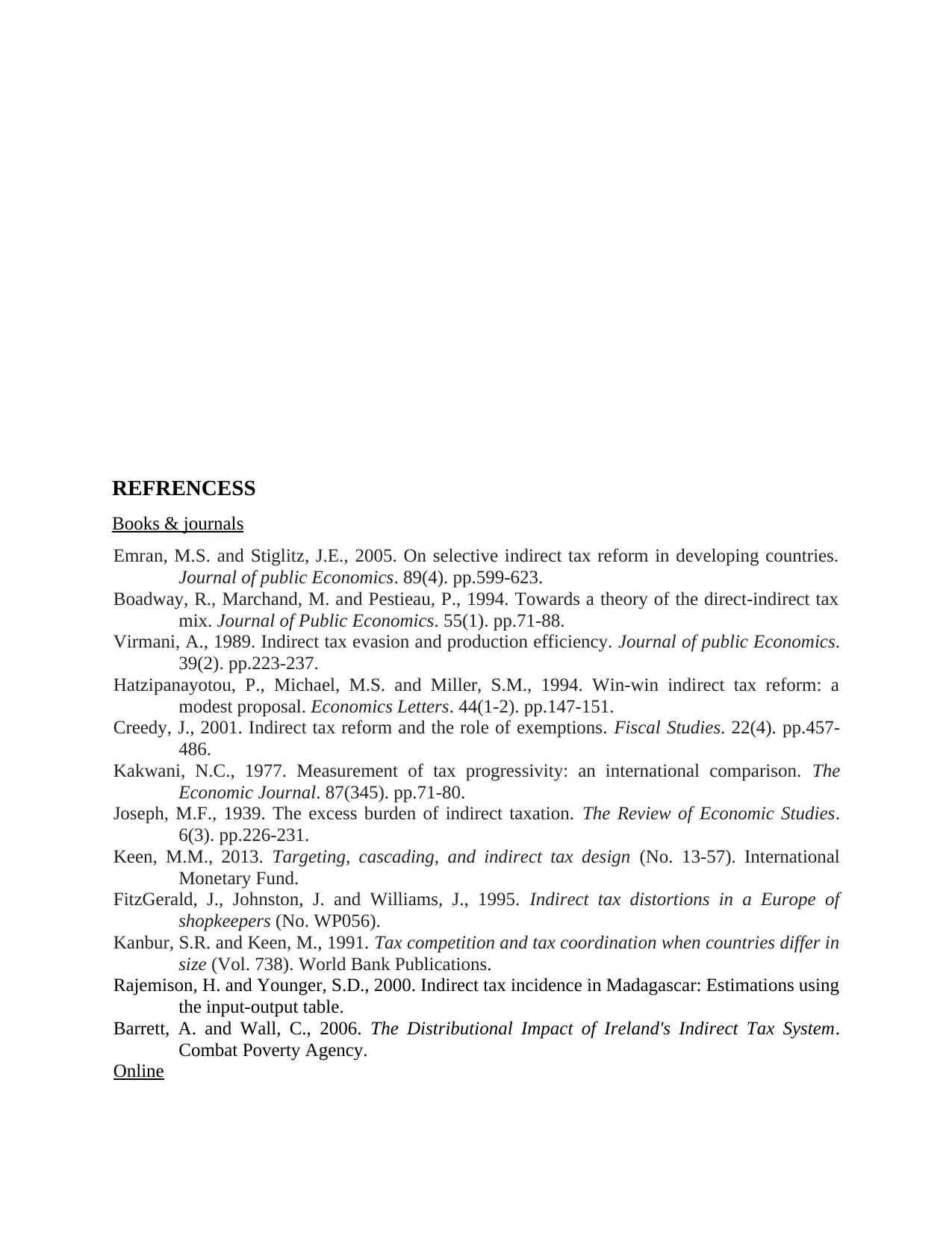
REFRENCESS
Books & journals
Emran, M.S. and Stiglitz, J.E., 2005. On selective indirect tax reform in developing countries.
Journal of public Economics. 89(4). pp.599-623.
Boadway, R., Marchand, M. and Pestieau, P., 1994. Towards a theory of the direct-indirect tax
mix. Journal of Public Economics. 55(1). pp.71-88.
Virmani, A., 1989. Indirect tax evasion and production efficiency. Journal of public Economics.
39(2). pp.223-237.
Hatzipanayotou, P., Michael, M.S. and Miller, S.M., 1994. Win-win indirect tax reform: a
modest proposal. Economics Letters. 44(1-2). pp.147-151.
Creedy, J., 2001. Indirect tax reform and the role of exemptions. Fiscal Studies. 22(4). pp.457-
486.
Kakwani, N.C., 1977. Measurement of tax progressivity: an international comparison. The
Economic Journal. 87(345). pp.71-80.
Joseph, M.F., 1939. The excess burden of indirect taxation. The Review of Economic Studies.
6(3). pp.226-231.
Keen, M.M., 2013. Targeting, cascading, and indirect tax design (No. 13-57). International
Monetary Fund.
FitzGerald, J., Johnston, J. and Williams, J., 1995. Indirect tax distortions in a Europe of
shopkeepers (No. WP056).
Kanbur, S.R. and Keen, M., 1991. Tax competition and tax coordination when countries differ in
size (Vol. 738). World Bank Publications.
Rajemison, H. and Younger, S.D., 2000. Indirect tax incidence in Madagascar: Estimations using
the input-output table.
Barrett, A. and Wall, C., 2006. The Distributional Impact of Ireland's Indirect Tax System.
Combat Poverty Agency.
Online
Books & journals
Emran, M.S. and Stiglitz, J.E., 2005. On selective indirect tax reform in developing countries.
Journal of public Economics. 89(4). pp.599-623.
Boadway, R., Marchand, M. and Pestieau, P., 1994. Towards a theory of the direct-indirect tax
mix. Journal of Public Economics. 55(1). pp.71-88.
Virmani, A., 1989. Indirect tax evasion and production efficiency. Journal of public Economics.
39(2). pp.223-237.
Hatzipanayotou, P., Michael, M.S. and Miller, S.M., 1994. Win-win indirect tax reform: a
modest proposal. Economics Letters. 44(1-2). pp.147-151.
Creedy, J., 2001. Indirect tax reform and the role of exemptions. Fiscal Studies. 22(4). pp.457-
486.
Kakwani, N.C., 1977. Measurement of tax progressivity: an international comparison. The
Economic Journal. 87(345). pp.71-80.
Joseph, M.F., 1939. The excess burden of indirect taxation. The Review of Economic Studies.
6(3). pp.226-231.
Keen, M.M., 2013. Targeting, cascading, and indirect tax design (No. 13-57). International
Monetary Fund.
FitzGerald, J., Johnston, J. and Williams, J., 1995. Indirect tax distortions in a Europe of
shopkeepers (No. WP056).
Kanbur, S.R. and Keen, M., 1991. Tax competition and tax coordination when countries differ in
size (Vol. 738). World Bank Publications.
Rajemison, H. and Younger, S.D., 2000. Indirect tax incidence in Madagascar: Estimations using
the input-output table.
Barrett, A. and Wall, C., 2006. The Distributional Impact of Ireland's Indirect Tax System.
Combat Poverty Agency.
Online
1 out of 14
Related Documents
Your All-in-One AI-Powered Toolkit for Academic Success.
+13062052269
info@desklib.com
Available 24*7 on WhatsApp / Email
![[object Object]](/_next/static/media/star-bottom.7253800d.svg)
Unlock your academic potential
© 2024 | Zucol Services PVT LTD | All rights reserved.





